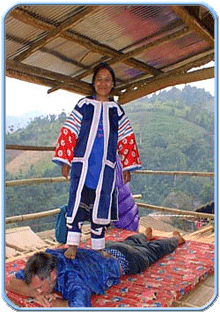

The Background of Keralite Foot Massage
(CHAVUTTI THIRUMMAL)
Kerala in the south of the Indian subcontinent is most commonly known in the West for its beautiful beaches and magnificent backwaters. But Kerala is also one of the major centers of traditional Indian medicine (Ayurveda), and the home of the ancient art of Kalaripayattu, South Indian martial arts. Kathakali, the classical dance of the region is another invaluable contribution of Kerala to world culture. Chavutti Thirummal, the Keralite foot massage, is part of that tradition and inseparably connected with Ayurveda, Kathakali and Kalaripayattu.
Kerala is one of the richest regions for classical and performing folk arts in India. The growth and development of such art forms had been highly influenced by the Kalari system through centuries. Many performing arts had been taking shape in the same social background and naturally they had been influenced by the institution of Kalari. The term Kalari is commonly used for the centers of training of both a combatant and an artiste. Literally it is a learning center of letters and physical culture. Several forms of theatre and dance developed out of the Kalari. Well known in the West is Kathakali dancing and it is interesting to note, that Keralite foot massage is practiced these days in schools of martial arts as well as in schools of Kathakali dance. A brief analytical study on the impact of Kalari on the performing arts in Kerala would reveal that the institution of Kalari had been responsible for nurturing the most popular and classical folk art forms in this region. The growth of these art forms and the growth of Kalari were interrelated. Even after the decline of Kalari, its influence was perpetuated in the artistic and aesthetic qualities of folk art forms and classical theatre like Kathakali. In reality, the institution of Kalari has become an inseparable part of the cultural heritage of Kerala.
Chavutti Thirummal involves massaging the body with healing oils, and is administered with the masseur holding on to a long rope for balancing. The masseur's body weight is used to press and relax the muscles and to work the energy lines. The massage is done partly with the heel, but mainly with the instep of the foot, while sometimes the toes are also used.
Chavutti Thirummal is a delicate balancing act with the rope and the masseur needs a tremendous amount of coordination, concentration and physical power.
The success of the massage depends on skillful application of weight and power by the masseur, his proficiency with the rope and his sensitivity in the foot he uses to press down on the patient, focussing on muscle and bone alignment. The masseur attempts to put the muscles and bones in their proper place and gently restores their elasticity and the flexibility of the patient.
At the same time a complete work out is given to the energy lines constituting the Pranamaya Kosha. In that respect Chavutti Thirummal is very similar to traditional Thai massage where the emphasis is identical. Although they appear to be very different on a superficial level, Chavutti Thirummal can be regarded as a close cousin of Thai massage, originating from the same yogic background, both having tremendous healing powers due to their depth of energy balancing.
Read more on Chavutti Thirummal Massage by Ermanno Visintainer on: ENGLISH or in ITALIAN.
